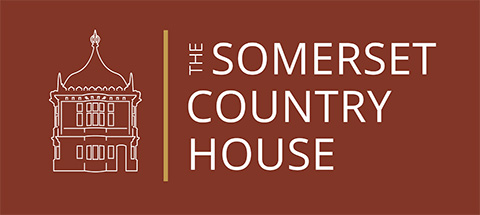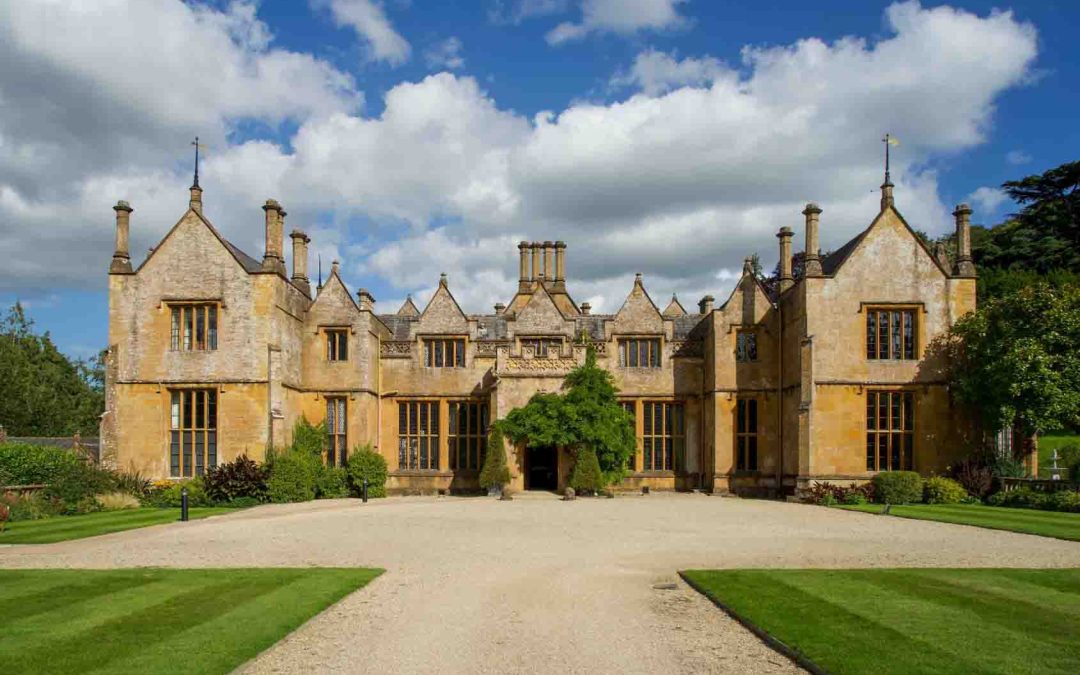In September 2023 Dillington House will no longer be run by Somerset County Council. It has provided a wonderful venue for residential adult education courses since 1949. In recent years the council expanded its offering as a venue for events, meetings, and weddings.
I have a lot of fond memories from the 25 years of my attendance at courses and lectures. In my days as a corporate manager, it was my weekend escape. The first course I attended was on the culture and art at the time of Chaucer and Richard II. Since then, I have studied the Anglo-Saxons, the Romans, medieval history, Shakespeare, architectural history of various periods, art history, classical Greece, philosophy, archaeology, etc., to name just a few. I have attended lectures by speakers such as Bettany Hughes, Mick Aston, and Lars Tharp, and many more. In the pandemic years the stables became a vaccination centre.
On my last course in August 2023, I took some photos as a reminder of the house and the joys I have gathered over the years. This house has had many a good conversation and much cheer. There have been losses and sadness along the way too. Now the house, in which I received so much education, made friends, and had some fabulous food, is finally shutting its doors. All good things come to an end at some point.
I have put together a collection of photographs below to illustrate the unique beauty of the house and grounds in this post.
Firstly, a potted history:
There has been a house present on the site for over 1000 years.
| c. 10th C | ‘Dylla’ owned the estate[i] |
| c. late 10th/early 11thCs | Ilminster given to the Abbey of Mulcheney[ii] |
| Late 11th C | Abbot of Mulcheney gives ‘Dylyngton’ to Hardinus de Meriet (or Harding Fitzeadnoth – his father had been an Anglo-Saxon who ended up affiliated to the Norman overlords. He gave the manor of ‘Dylyngton’ to his younger brother Sigeward.[iii] |
| Sigeward takes the patronymic of ‘de Dillington’[iv] | |
| 1240 | First record of the name – Emma de Dillington, daughter of Henri de Dillington made a grant of 9 acres of land to the church at Ilminster and to the Abbot of Mulcheney in memory of members of her family. The income was to provide for prayers said in perpetuity for herself and family members after death.[v] |
| 1415 | Richard de Dilliington is referred to as Lord of the manor of West Dillington, which is probably where the house stands today.[vi] |
| Until the late 16th C | The Bonvilles acquire Dillington[vii] |
| 1599 | The Speke family acquired Dillington from Richard Bonville in 1599.[viii] |
| c. 1600 | The house was extended by Sir George Speke (d. 1637). The Spekes had held White Lackington manor (down the road from Dillington) since the 15th C.[ix]
Thomas Gerard of Trent wrote in 1633: “… when Sir George Speake, next neighbour unto it, bought it; taken with the pleasantnes of the place and neernes of his mansion-house, there being only his parke betweene them hath built much at it, and made a fine convenient place of it where his eldest sonne now lives.”[x The early-17th C house fabric exists within the north wing. |
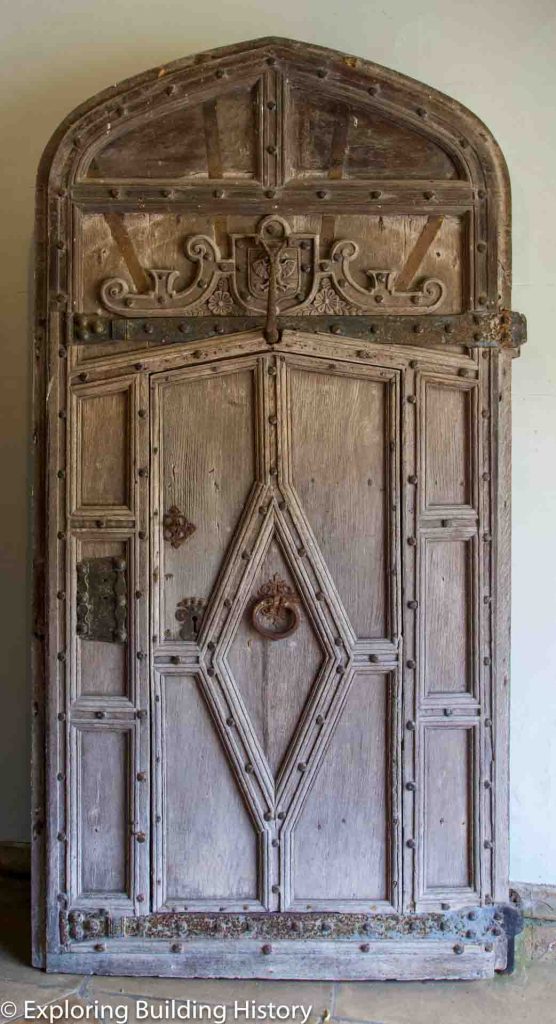
Original door of early-17th C house
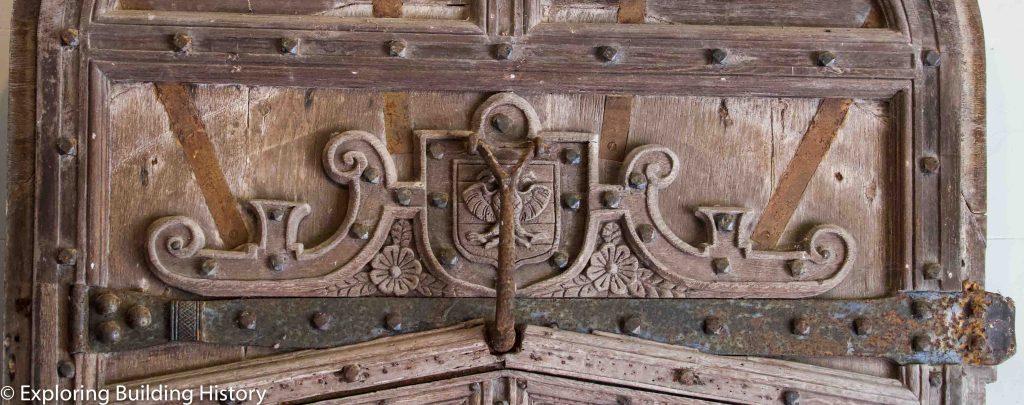
Armorial of the Speke family is a double-headed eagle, which can be seen here behind the door knocker. The name ‘Speke’ is anglicised from ‘L’Espec’, which translates from Norman French as a woodpecker. The double-headed eagle can also be seen in Bayeaux Cathedral, which may link to the origins of the family. [xi]
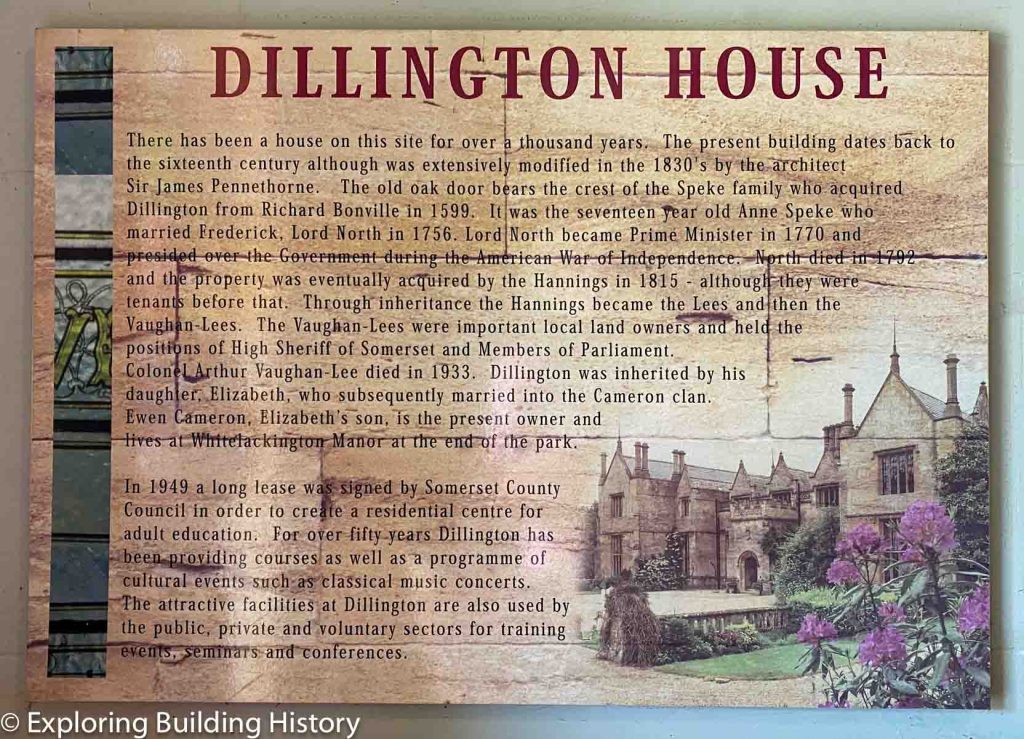
Sign in Dillington House Porch
| c. 1750-60s | The house was altered by Lord North (1732-1972). Lord North was Prime Minster from 1770 to 1782 and had married Anne Speke, the daughter and heir of George Speke of White Lackington, in 1756. Anne had inherited Dillington in 1753. Dillington probably provided a modest yield of £750 per annum.[xii] £750 is approximately £134K today.[xiii] |
| After Lord North’s death in 1792 the house was eventually acquired by the Hannings in 1815 (although they were tenants beforehand).[xiv] | |
| 1834 | The Hannings became the ‘Lees’ – John Lee Hanning (1802-1874) the son of William Hanning of Dillington House (d. 1834) inherited Dillington. His name ended as John Lee Lee.[xv] |
| c. 1837 | John Lee Lee had the house extensively modernised by the architect Sir James Pennethorne (1801-1871)[xvi], keeping the theme of the early-17th C house. |
| 20th to 21st Cs | The ‘Lees’ and then ‘Vaughan-Lees’. Colonel Arthur Vaughan Lee died in 1933 and Dillington was inherited by his daughter Elizabeth. Elizabeth married into the Cameron family, who own the estate today.[xvii] |
SIR JAMES PENNETHORE (Architect: 1801-1871)
Sir James Pennethorne was the son of a hop merchant from Worcester. He worked in the London office of the architect John Nash. He was a second cousin of Nash’s wife. Nash arranged for him to be taught drawing by Augustus Charles Pugin in 1821-3. Nash also financed his two years of foreign travel and study, starting in October 1824, with most of his time spent in Rome. Here he carried out an intensive study of classical and Renaissance buildings. He also visited Sicily to study the Greek temples there and then spent time in the Paris office of Pugin’s brother-in-law Louis Lafitte.[xviii]
His independent career got off to a slow start. His first building, delegated by Nash to him, was Crockford’s Bazaar at 10 St James’ Street, carried out in 1831-32. Dillington was remodelled by him in c. 1837. The main part of his professional work was focused from the 1840s on metropolitan improvements and the surveyorship of the crown estate in London. He became in effect the ‘government architect’, shaping mid-Victorian London with the design of new streets and parks. In 1852-6 he designed a new west wing at Somerset House for the Inland Revenue, in line with the main building by Sir William Chambers – for which he was awarded a special gold medal by the Royal Institute of British Architects (RIBA) in 1857.At Buckingham Palace in 1852-6 he added a new south range, including a lavish ballroom and supper room. He received a RIBA Gold Medal in 1865 and a knighthood in November 1870. He died just a year after receiving his knighthood and was buried in Highgate cemetery.[xix]
Dillington was an early commission in Pennethorne’s career. He was 36 years old. Some of the elements are said to have come from Barrington Court.[xx]
Curiously Pugin died when he was 40 after a life of working astonishingly hard.
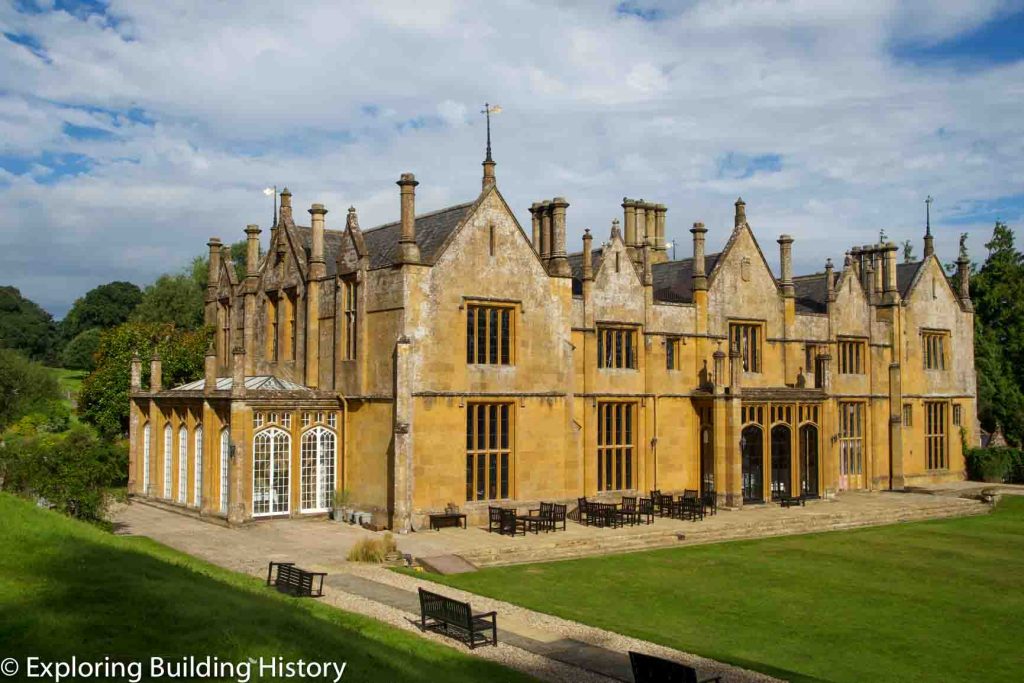
East side of Dillington House with the Orangery on the south side.
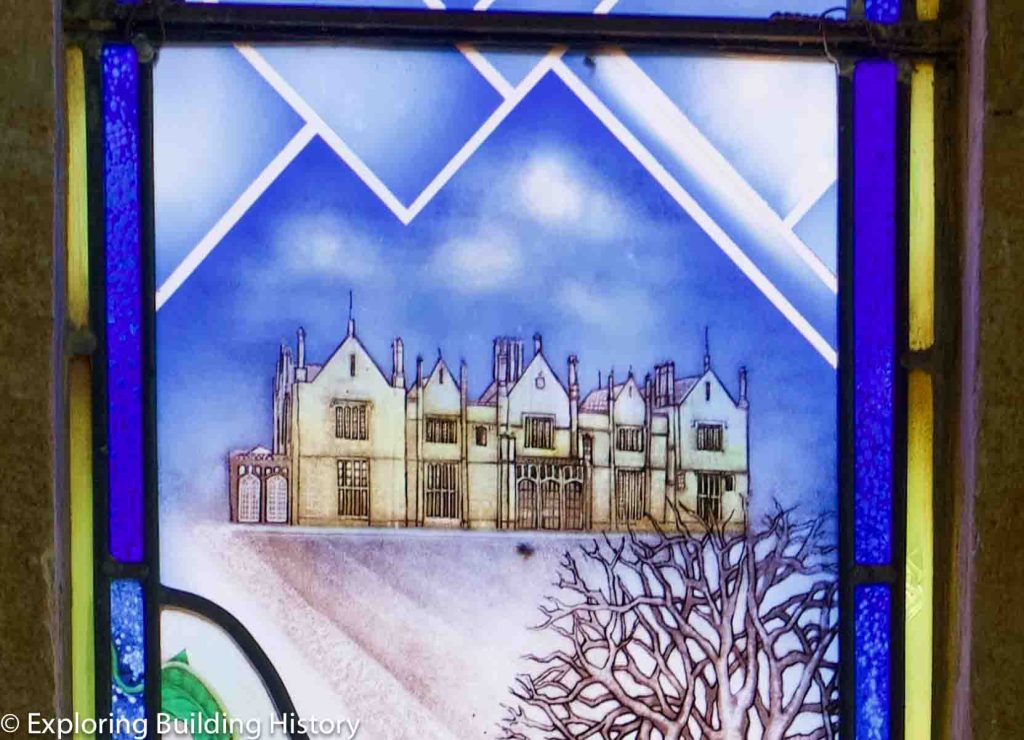
Dillington House in Stained Glass at the church of St. Mary, Whitelackington. Depicted in a memorial window to Elizabeth Cameron and her husband.
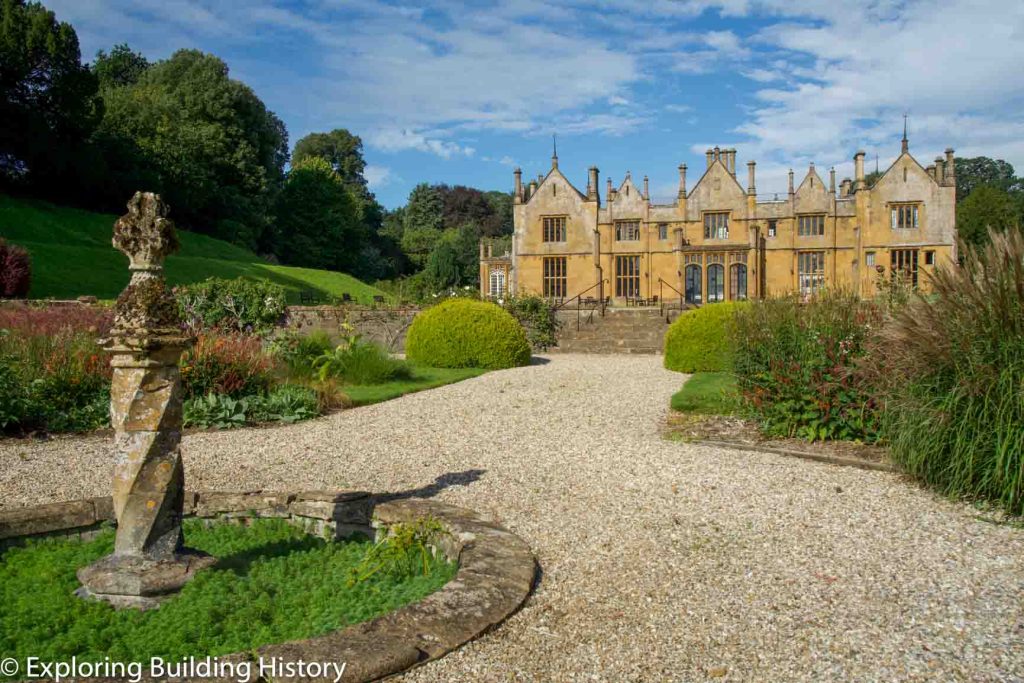
Was this an old barley-twist stack that came from Barrington Court?
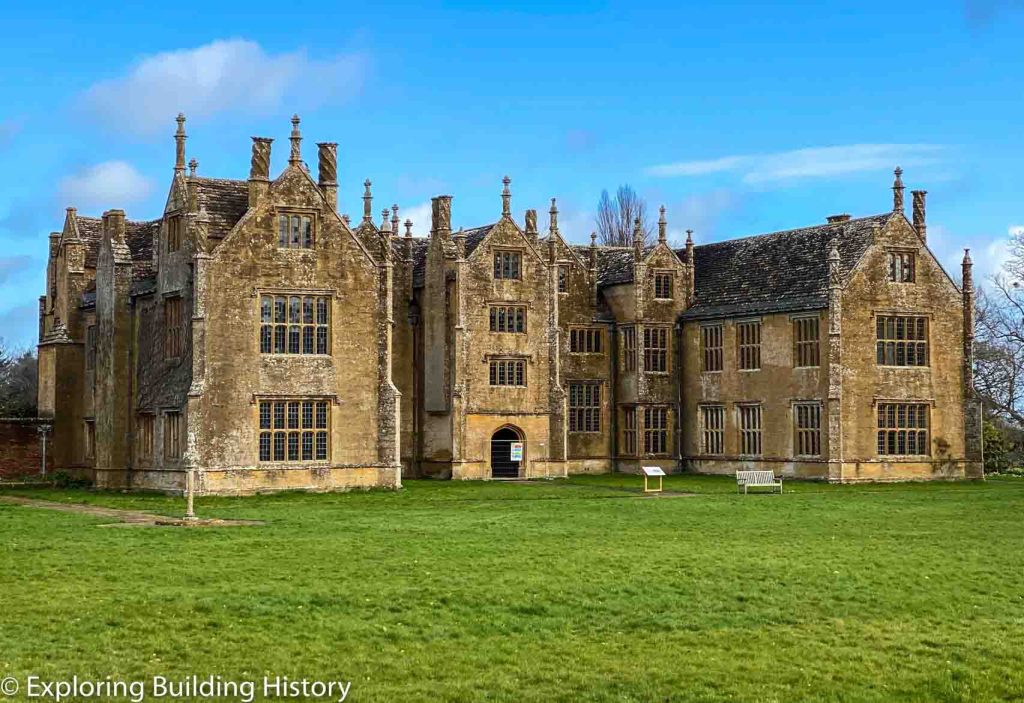
Barrington Court, circa 1514 for Henry Daubeney and perhaps completed by circa 1558 for William Clifton.[xxi] A barley-twist stack or finial appears to be missing on the right wing – could this be the one at Dillington?
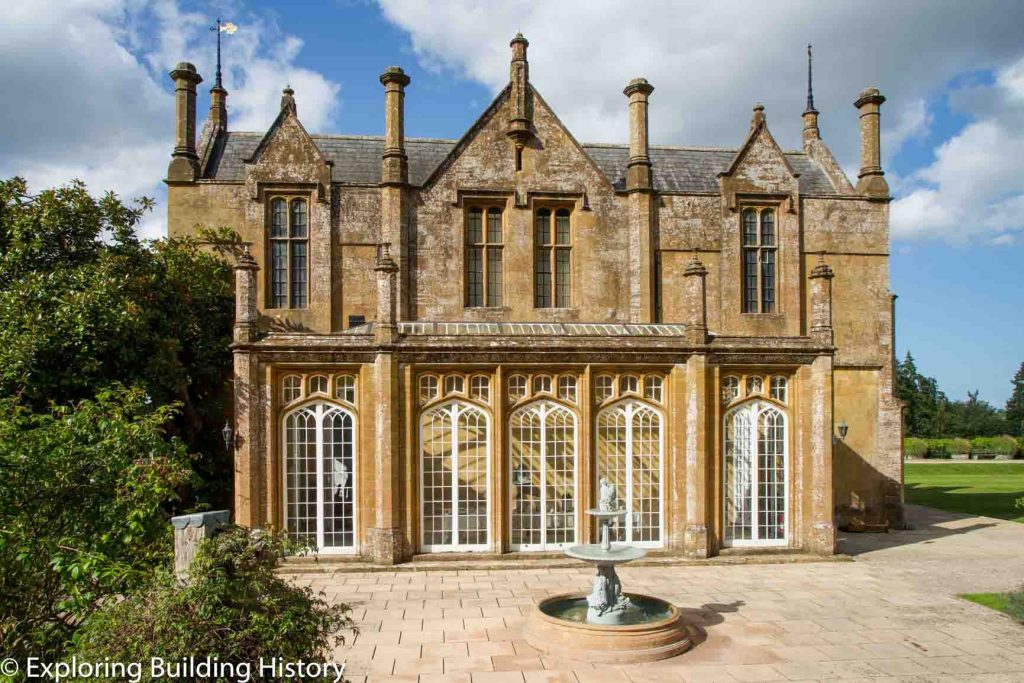
The Orangery on the south side of the house. The Victorians did like orangeries and conservatories.

Upper part of a memorial window to Elizabeth Cameron (d. 2008) and her husband Major Allen Cameron (d.2011). In the lower part of the glass is a poem written by Elizabeth:
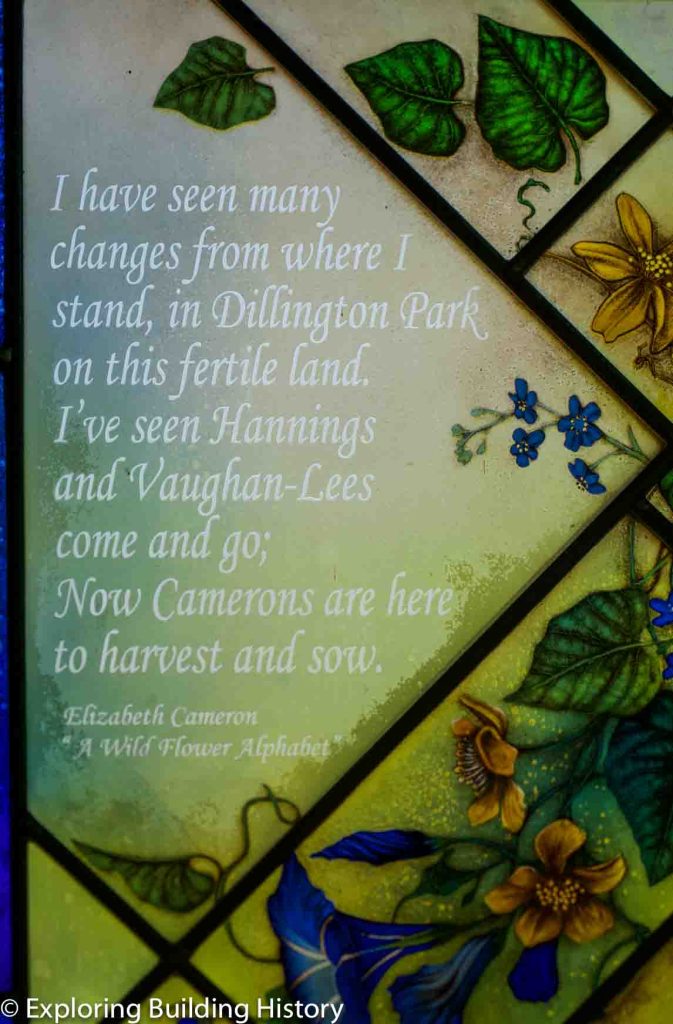
And now there are changes again. I have enjoyed Dillington House as part of my own life history. I hope it thrives in its new incarnation, whatever that might be. I shall miss it greatly as a beacon of learning and all those who I have encountered over the years!
NOTES
[i] Nancy Smith, The Story of Dillington: A Thousand Years, (Taunton: Somerset County Council, 2000), p.1.
[ii] Smith, p. 1.
[iii] Smith, p. 2.
[iv] Smith, p. 3.
[v] Smith, p. 3.
[vi] Smith, p. 4.
[vii] Smith, p. 4.
[viii] Sign at Dillington House in the porch.
[ix] Smith, p. 5.
[x] Thomas Gerard of Trent, The Particular Description of the County of Somerset, (Somerset Record Society Vol. XV: drawn up 1633, ed. The Rev. E. H. Bates, 1900), p. 138.
[xi] Smith, p. 5.
[xii] Geoffrey Tyack, ‘Pennethore, Sir James (1801 – 1871), Oxford Dictionary of National Biography, Oxford University Press, 2004: online edn. Jan 2008, https://doi.org/10.1093/ref:odnb/21869 [accessed 27 August 2023].
[xiii] ‘Inflation Calculator’, Bank of England, https://www.bankofengland.co.uk/monetary-policy/inflation/inflation-calculator [accessed 28 August 2023].
[xiv] Sign at Dillington House in the porch.
[xv] D. R. Fisher (ed.), ‘LEE, John Lee (1802-1874), of Orleigh Court, nr. Bideford, Devon’, The History of Parliament: the House of Commons 1820-1832, (Cambridge University Press, 2009), http://www.historyofparliamentonline.org/volume/1820-1832/member/lee-john-1802-1874 [accessed 28 August 2023].
[xvi] Tyack, ‘Pennethore, Sir James (1801 – 1871)’.
[xvii] Sign at Dillington House in the porch.
[xviii] Tyack, ‘Pennethore, Sir James (1801 – 1871)’.
[xix] Tyack, ‘Pennethorne, Sir James (1801 – 1871)’.
[xx] ‘Dillington House’, Historic England List Entry 1057040, (1958), https://historicengland.org.uk/listing/the-list/list-entry/1057040?section=official-list-entry [accessed 28 August 2023].
[xxi] ‘Barrington Court’, Historic England List Entry 1345920, (1959), https://historicengland.org.uk/listing/the-list/list-entry/1345920?section=official-list-entry [accessed 28 August 2023].
BIBLIOGRAPHY
Smith, Nancy, The Story of Dillington: A Thousand Years, (Taunton: Somerset County Council, 2000)
Thomas Gerard of Trent, The Particular Description of the County of Somerset, (Somerset Record Society Vol. XV: drawn up 1633, ed. The Rev. E. H. Bates, 1900)
